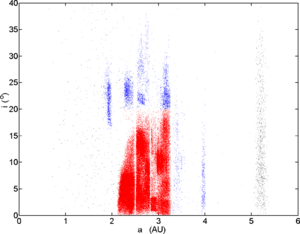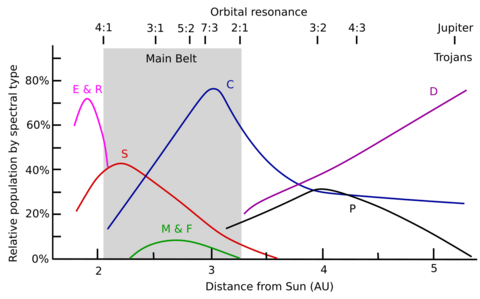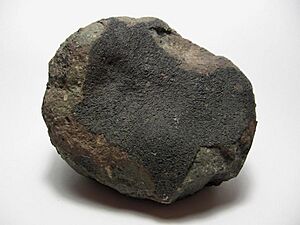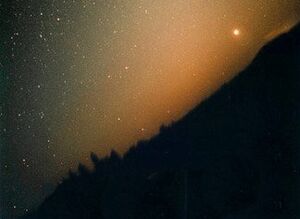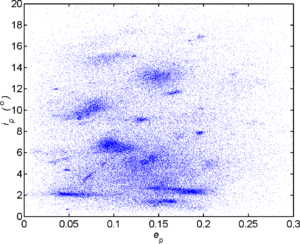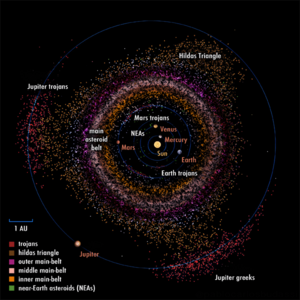Asteroid belt facts for kids
The asteroid belt is a huge, donut-shaped area in our Solar System. It circles the Sun between the orbits of Mars and Jupiter. This area is home to countless solid, rocky objects called asteroids or minor planets. These objects come in many sizes, but they are all much smaller than planets. On average, they are about one million kilometers apart, so space probes can travel through the belt safely.
We often call it the main asteroid belt to tell it apart from other groups of asteroids in the Solar System. It's the closest and smallest "disk" of material orbiting the Sun, besides the planets themselves.
The four largest asteroids in the main belt are Ceres, Vesta, Pallas, and Hygiea. Together, they make up about 60% of the belt's total mass. Ceres is the biggest, about 950 kilometers wide, and is even considered a dwarf planet. The entire asteroid belt has a total mass equal to only about 3% of our Moon.
Scientists believe the asteroid belt formed from tiny building blocks called planetesimals. These were the early pieces that could have formed a planet. However, Jupiter's strong gravity kept them from coming together. Instead, Jupiter's pull caused them to crash into each other, breaking them apart. This is why we have many small asteroids instead of one large planet between Mars and Jupiter.
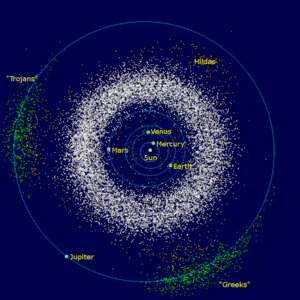
| Sun Jupiter trojans Orbits of planets |
Asteroid belt Hilda asteroids (Hildas) Near-Earth objects (selection) |
Contents
Discovering the Asteroid Belt
For a long time, scientists wondered if there was a planet between Mars and Jupiter. In 1596, Johannes Kepler even wrote about this idea. Later, a pattern in planet distances, called the Titius-Bode Law, suggested a "missing planet" in that space.
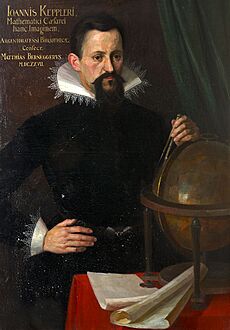
Finding Ceres and Pallas
On January 1, 1801, an astronomer named Giuseppe Piazzi found a small, moving object. He named it "Ceres." It fit the predicted spot for the missing planet. About 15 months later, Heinrich Olbers found another object, Pallas, in the same area.
These new objects looked like tiny points of light, not like the round planets seen through telescopes. In 1802, William Herschel suggested a new name for them: "asteroids." This Greek word means "star-like."
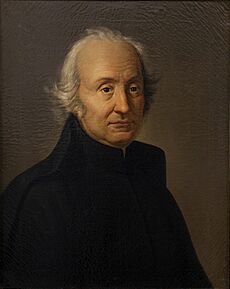
More Discoveries and New Names
By 1807, two more asteroids, Juno and Vesta, were found. For a while, people still called them planets. But as more and more were discovered, it became clear they were different. In the 1850s, the term "asteroid belt" became popular.
The invention of astrophotography in 1891 by Max Wolf made finding asteroids much faster. By 2000, over 100,000 asteroids had been found! Today, special computer systems automatically find new ones all the time.
Water on Ceres
In 2014, scientists from the European Space Agency (ESA) made an exciting discovery. They found water vapor coming from Ceres! This was surprising because water plumes are usually seen on comets, not asteroids. This finding showed that asteroids can be more like comets than we thought.
How the Asteroid Belt Formed
Scientists believe the Solar System began as a cloud of dust and gas. This cloud slowly came together to form the Sun and planets. Tiny particles stuck together, growing into larger clumps called planetesimals. These planetesimals were the building blocks of planets.
Jupiter's Strong Influence
In the area where the asteroid belt is now, Jupiter's powerful gravity played a big role. Jupiter's pull kept the planetesimals from fully combining into a single large planet. Instead, its gravity made them crash into each other at high speeds. These collisions shattered them into many smaller pieces.
This is why the asteroid belt has so many small objects instead of one big planet. Over time, most of the original material in the belt was lost. It was either thrown out of the Solar System or crashed into other planets.
Asteroid Changes Over Time
Early in the Solar System's history, some asteroids melted inside. This allowed heavier materials to sink to the center, like how Earth has a core. But because asteroids are small, this melting period was short.
Asteroids are not exactly as they were when they first formed. They have changed a lot from impacts, radiation from the Sun, and tiny dust particles hitting them.
What the Asteroid Belt is Like
The asteroid belt is mostly empty space. The asteroids are spread out over such a huge area that it's rare for a spacecraft to hit one. Still, there are hundreds of thousands of known asteroids. Scientists think there could be millions more that are 1 kilometer or larger.
The total mass of all the asteroids in the belt is about 3% of the Moon's mass. The four largest objects—Ceres, Vesta, Pallas, and Hygiea—make up about 62% of this total mass. Ceres alone accounts for 39% of the belt's mass.
What Asteroids are Made Of
Asteroids in the main belt generally fall into three main types based on what they are made of:
- C-type (Carbon-rich) asteroids: These are dark and contain a lot of carbon. They are most common in the outer parts of the belt.
- S-type (Silicate-rich) asteroids: These are brighter and contain rocky materials like silicates and some metals. They are more common closer to the Sun.
- M-type (Metal-rich) asteroids: These are found in the middle of the belt and seem to be made mostly of iron and nickel. Some might be the cores of larger asteroids that broke apart.
Main-Belt Comets
Some asteroids in the outer belt act like comets. They show activity like releasing gas, even though they are in the asteroid belt. Scientists think these "main-belt comets" might have ice hidden beneath their surfaces. Small impacts could expose this ice, causing it to turn into gas. These icy asteroids might have even brought water to Earth's oceans long ago.
Asteroid Orbits and Gaps
Most asteroids in the belt have orbits that are fairly round and lie close to the plane of the planets. However, some have more stretched-out orbits or travel further above or below the main plane.
Kirkwood Gaps
In 1866, Daniel Kirkwood noticed empty spaces in the asteroid belt. These are called Kirkwood gaps. They appear at distances where an asteroid's orbit around the Sun would be a simple fraction of Jupiter's orbit. Jupiter's strong gravity pulls on asteroids in these spots, pushing them into different orbits and creating these gaps.
Collisions and Dust
The asteroid belt is a busy place over billions of years. Asteroids often crash into each other. A big collision can break an asteroid into many smaller pieces, forming an asteroid family. Sometimes, if they collide slowly, two asteroids can even join together.
Most asteroids between 200 meters and 10 kilometers wide are thought to be "rubble piles." This means they are collections of smaller rocks held together by their own weak gravity.
Space Dust and Zodiacal Light
Collisions also create tiny dust particles. This fine dust, along with material from comets, forms a faint glow in the night sky called the zodiacal light. You can sometimes see it extending from the direction of the Sun. This dust slowly spirals inward toward the Sun. New dust must be constantly made in the asteroid belt to keep the zodiacal light visible.
Meteorites from the Belt
When asteroids collide, some of the debris can become meteoroids. These sometimes enter Earth's atmosphere. Scientists believe that almost all of the meteorites found on Earth came from the asteroid belt.
Asteroid Families
In 1918, astronomer Kiyotsugu Hirayama noticed that some asteroids travel in similar orbits. These groups are called asteroid families. They likely formed from a single, larger asteroid that broke apart in a collision.
About one-third of the asteroids in the main belt belong to a family. These families have similar orbital paths and are often made of similar materials. Some well-known families include the Flora, Eunomia, Koronis, Eos, and Themis families.
Recent Family Formations
Some asteroid families are quite young in space terms. For example, the Karin family formed about 5.7 million years ago from a collision. The Veritas family formed about 8.3 million years ago. These recent collisions continue to add new dust and small asteroids to the belt.
Exploring the Asteroid Belt
Many spacecraft have traveled through the asteroid belt on their way to other planets. The first was Pioneer 10 in 1972. Scientists were worried about collisions, but it passed through safely. Since then, many other probes, like Pioneer 11, Voyagers 1 and 2, and Ulysses, have also crossed the belt without problems.
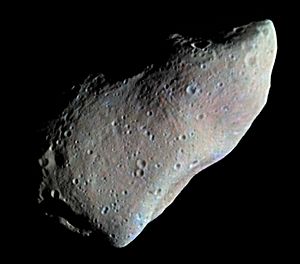
Missions to Asteroids
Most images of main-belt asteroids come from probes flying past them on their way to other destinations.
- The Galileo spacecraft imaged 951 Gaspra in 1991 and 243 Ida in 1993.
- The NEAR probe imaged 253 Mathilde in 1997.
- Cassini imaged 2685 Masursky in 2000.
- Stardust imaged 5535 Annefrank in 2002.
- New Horizons imaged 132524 APL in 2006.
- Rosetta imaged 2867 Šteins in 2008 and 21 Lutetia in 2010.
The Dawn mission was special because it orbited two main-belt asteroids for a long time. It studied Vesta from 2011 to 2012 and has been orbiting Ceres since 2015.
More recently, the Lucy space probe flew past 152830 Dinkinesh in 2023. The Psyche spacecraft is a NASA mission heading to the large metal-rich asteroid 16 Psyche.
See also
 In Spanish: Cinturón de asteroides para niños
In Spanish: Cinturón de asteroides para niños
- Asteroid mining
- Exoasteroid belt
- List of exceptional asteroids
- List of missions to minor planets
- Trojan asteroid



